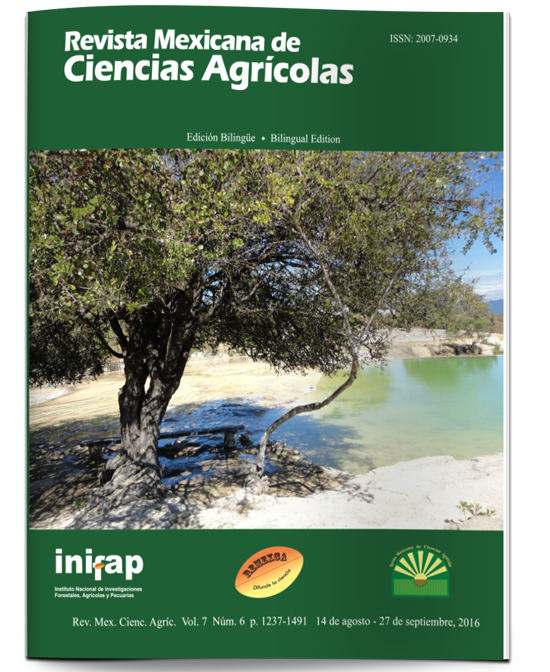Identification of Mexican maize races adapted to moisture deficient conditions using biogeographical data
DOI:
https://doi.org/10.29312/remexca.v4i6.1152Keywords:
drought adaptation, climate change, maize races, genetic resourcesAbstract
We worked with a database of recent accessions of 54 races of maize from Mexico, whose passport details were extracted from the Genetic Resource Unit from INIFAP ́s Germplasm Bank. From the geographical coordinates of the accessions, was made an accession characterization by site, conditions of moisture availability for the period from May to October for the development of maize, based on the environmental information system from INIFAP and the IDRISI Andes system. With these data, a statistical analysis was made that included an analysis of variance and analysis of numerical taxonomy (cluster analysis) with the product moment correlation between races. Additionally was performed an accessions analysis by race to identify the accessions that developed under moisture-deficient environments. Accessions were selected with adaptation to an environment with humidity index (IH) (precipitation / potential evapotranspiration) from May to October less than 0.5. The results showed the identification of five racial groups, of which one of them stood out for its adaptation to an HI between 0.39 and 0.53. This group included Chapalote, Dulcillo Northwest, Tuxpeño Norteño, Conical Norteño, Tablilla of Ocho and Gordo races. Accessions analysis reported the presence of maize in a total of 677 sites with semi-arid conditions in the May-October season. The 677 accessions represent 24 races. These results suggest that in Mexico there are genetic resources, related to the races of maize, which could be useful in breeding programs aimed to maize adaptation to drought stress.
Downloads
Downloads
Published
How to Cite
Issue
Section
License
The authors who publish in Revista Mexicana de Ciencias Agrícolas accept the following conditions:
In accordance with copyright laws, Revista Mexicana de Ciencias Agrícolas recognizes and respects the authors’ moral right and ownership of property rights which will be transferred to the journal for dissemination in open access. Invariably, all the authors have to sign a letter of transfer of property rights and of originality of the article to Instituto Nacional de Investigaciones Forestales, Agrícolas y Pecuarias (INIFAP) [National Institute of Forestry, Agricultural and Livestock Research]. The author(s) must pay a fee for the reception of articles before proceeding to editorial review.
All the texts published by Revista Mexicana de Ciencias Agrícolas —with no exception— are distributed under a Creative Commons License Attribution-NonCommercial 4.0 International (CC BY-NC 4.0), which allows third parties to use the publication as long as the work’s authorship and its first publication in this journal are mentioned.
The author(s) can enter into independent and additional contractual agreements for the nonexclusive distribution of the version of the article published in Revista Mexicana de Ciencias Agrícolas (for example include it into an institutional repository or publish it in a book) as long as it is clearly and explicitly indicated that the work was published for the first time in Revista Mexicana de Ciencias Agrícolas.
For all the above, the authors shall send the Letter-transfer of Property Rights for the first publication duly filled in and signed by the author(s). This form must be sent as a PDF file to: revista_atm@yahoo.com.mx; cienciasagricola@inifap.gob.mx; remexca2017@gmail.
This work is licensed under a Creative Commons Attribution-Noncommercial 4.0 International license.



